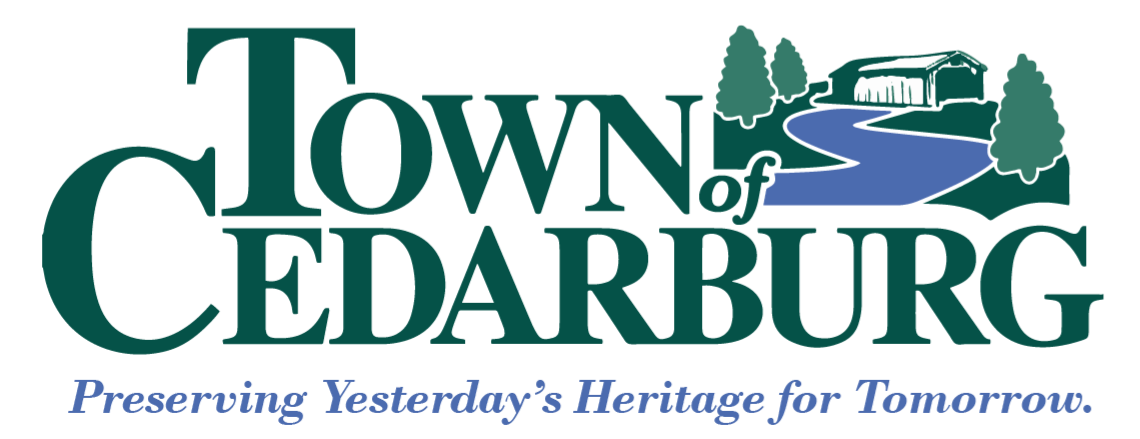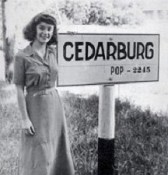The Cedarburg area was first recognized in the 1840s. The name Cedarburg most likely was given due to the abundant forests in the area. On March 2, 1849, the Town of Cedarburg became a civil town of Washington County [Source: Harrsch, Patricia G. Civil Towns of Wisconsin (Madison: State Historical Society of Wisconsin Library, 1998), and U.S. Geographic Names Information Server]. The Town was "set off" to Ozaukee County on March 7, 1853. The Town has much history, including the last covered bridge in the state of Wisconsin (see history below), an example of octagon architecture circa 1845-1860 in an old schoolhouse now used as a residence on Pleasant Valley Road, and the Hamilton Historic District, which includes Turn Halle (1867), Hamilton School House and the Concordia Grist Mill (1853).
Covered Bridge
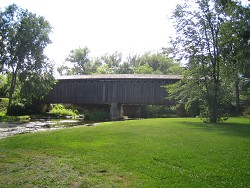 Built in 1876 by the Town of Cedarburg, the Covered Bridge original span measured 120 feet long and 12 feet wide. Its construction was of a certain type of pine found near Baraboo, Wisconsin. All of the timber and planks were cut and squared in a mill near that city. The lumber was then hauled to the proposed site on Cedar Creek, where all pieces were fitted and set in place. The type of construction is known as lattice truss with interlacing 3 x 10 inch planks all held together by 2-inch hardwood pins and floored with three-inch planking. It is now very rare. In 1927, a center abutment was placed to carry the heavier traffic of automobiles and trucks. There were many prominent farmers living in the vicinity of this covered bridge, whose descendants are still living in this area. The names of some of these early settlers were the Kaehlers, Krohns, Ernsts, Hickeys, Corrigans, Mintzlaffs, Schellenbergs and Pollows. In 1940, the Ozaukee County Board voted to forever preserve this structure as an historic monument. Many and varied reasons are given to why such bridges were covered. Some say it was to shelter travelers in storms and others hint of refuge from American Indians. There are two more reasonable conclusions - to preserve the truss structure and the fact that the teams of oxen used by farmers in the area had a fear of crossing the water on an open bridge and frequently balked. One old legend states that the covered bridge leveled off the farmers' hayloads as they passed through. Another local legend has it that a member of a county crew once drove through this bridge with his tractor, fully equipped with a snowplow and dragging scrapers. Suddenly realizing that tractors were strictly prohibited, he turned around, recrossed the bridge, and splashed his way back through the creek, confident that his wrong had been righted. On October 1, 1955, the Port Washington Chapter, Daughters of the American Revolution, added to the bridge its one modern embellishment, a plaque which reads: 1876 - 1955 Last Covered Bridge in Wisconsin.
Built in 1876 by the Town of Cedarburg, the Covered Bridge original span measured 120 feet long and 12 feet wide. Its construction was of a certain type of pine found near Baraboo, Wisconsin. All of the timber and planks were cut and squared in a mill near that city. The lumber was then hauled to the proposed site on Cedar Creek, where all pieces were fitted and set in place. The type of construction is known as lattice truss with interlacing 3 x 10 inch planks all held together by 2-inch hardwood pins and floored with three-inch planking. It is now very rare. In 1927, a center abutment was placed to carry the heavier traffic of automobiles and trucks. There were many prominent farmers living in the vicinity of this covered bridge, whose descendants are still living in this area. The names of some of these early settlers were the Kaehlers, Krohns, Ernsts, Hickeys, Corrigans, Mintzlaffs, Schellenbergs and Pollows. In 1940, the Ozaukee County Board voted to forever preserve this structure as an historic monument. Many and varied reasons are given to why such bridges were covered. Some say it was to shelter travelers in storms and others hint of refuge from American Indians. There are two more reasonable conclusions - to preserve the truss structure and the fact that the teams of oxen used by farmers in the area had a fear of crossing the water on an open bridge and frequently balked. One old legend states that the covered bridge leveled off the farmers' hayloads as they passed through. Another local legend has it that a member of a county crew once drove through this bridge with his tractor, fully equipped with a snowplow and dragging scrapers. Suddenly realizing that tractors were strictly prohibited, he turned around, recrossed the bridge, and splashed his way back through the creek, confident that his wrong had been righted. On October 1, 1955, the Port Washington Chapter, Daughters of the American Revolution, added to the bridge its one modern embellishment, a plaque which reads: 1876 - 1955 Last Covered Bridge in Wisconsin.
Hamilton Schoolhouse
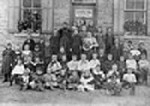 The Hamilton Schoolhouse was built in 1887 and was used to educate children in first through eighth grade until 1958. The school closed that year, and students who had attended Hamilton Schoolhouse were sent to Cedarburg schools. Today, the Hamilton Schoolhouse is owned by the Rudich family and used as a quilt shop. For more on the Hamilton Historic District, click here.
The Hamilton Schoolhouse was built in 1887 and was used to educate children in first through eighth grade until 1958. The school closed that year, and students who had attended Hamilton Schoolhouse were sent to Cedarburg schools. Today, the Hamilton Schoolhouse is owned by the Rudich family and used as a quilt shop. For more on the Hamilton Historic District, click here.
Turn Halle
Click here to view a short video on the renovation of this historic structure.
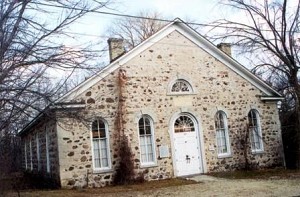 Turn Halle was built in 1867 and was used as a combination meeting place and gymnasium for members of the Hamilton Turnverein society for more than 20 years. This building is the last of its kind existing in the United States. When the society disbanded, the building saw use as a shoe factory and later as a cider mill. The building fell into disrepair in the middle part of the 20th century. On July 1, 1976, Turn Halle was entered on the National Register of Historic Places. The building was then donated to the Town of Cedarburg and the Cedarburg Landmark Preservation Society by Adelaide B. Mill. Funds for restoration were provided by a combination of donations from local citizens and a matching grant from the National Park Service, which was obtained through the State Historical Society of Wisconsin. The building was most recently purchased by Henke & Associates for renovation and use as an advertising firm (Information for this historical information came from the commemorative plaque placed on the building by the Cedarburg Landmarks Preservation Society, May 1, 1983).
Turn Halle was built in 1867 and was used as a combination meeting place and gymnasium for members of the Hamilton Turnverein society for more than 20 years. This building is the last of its kind existing in the United States. When the society disbanded, the building saw use as a shoe factory and later as a cider mill. The building fell into disrepair in the middle part of the 20th century. On July 1, 1976, Turn Halle was entered on the National Register of Historic Places. The building was then donated to the Town of Cedarburg and the Cedarburg Landmark Preservation Society by Adelaide B. Mill. Funds for restoration were provided by a combination of donations from local citizens and a matching grant from the National Park Service, which was obtained through the State Historical Society of Wisconsin. The building was most recently purchased by Henke & Associates for renovation and use as an advertising firm (Information for this historical information came from the commemorative plaque placed on the building by the Cedarburg Landmarks Preservation Society, May 1, 1983).
Concordia Mill
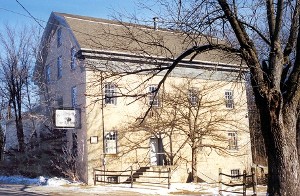 The Concordia Grist Mill was built in 1853 in Hamilton. Hamilton, originally settled by Irish immigrants and called New Dublin, was given the name Hamilton when William S. Hamilton, a son of Alexander Hamilton, spent the night at what became the first stagecoach stop between Milwaukee and Green Bay.
The Concordia Grist Mill was built in 1853 in Hamilton. Hamilton, originally settled by Irish immigrants and called New Dublin, was given the name Hamilton when William S. Hamilton, a son of Alexander Hamilton, spent the night at what became the first stagecoach stop between Milwaukee and Green Bay.
Kaehler's Mill
At the intersection of present day Covered Bridge and Kaehlers Mill roads in the Town of Cedarburg was the local crossroad community of Kaehlers Mill. According to Uhlig family history, the Carl Uhlig family emigrated from Saxony, Germany, in about 1847. The family had been millers in their native town. Upon reaching the port of New York, Carl passed away in Buffalo, NY. His widow and five children then left New York, settling on 80 acres in the Town of Cedarburg, which encompassed almost one quarter mile of Cedar Creek. Click here for more on Kaehlers Mill.
Historic Cedarburg Maps & Barn Survey
Many of those who make their first visit to Town Hall comment on the unique collection of antique farming implements and other tools, as well as the colletion of black and white pictures illustrating the rich past of the Cedarburg community. Another way to turn back the clock is to look at old plat maps. To view a handful of these old maps from various years, click on the year: 1873, 1915, 1921, 1939, 1948. You can also click here to view a map and guide to historic structures located in the Hamilton Historic District.
The Town also maintains a Barn Survey that was assembled in 1996 by the Town Landmarks Commission. The purpose of the survey was to take a, "photo journey through the Town of Cedarburg to make a count of these great buildings of our past and present." This record is important as many of these structures are giving way to subdivisions or falling apart due to lack of maintenance.
